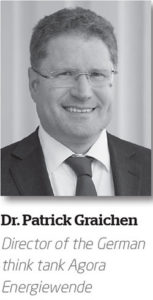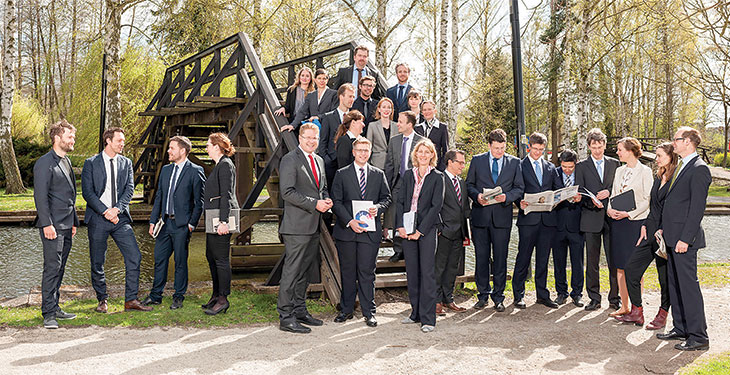By 2022 Germany will have shut down the very last nuclear plant, as by now half of the capacities being decommissioned. Europe’s richest economy has reached a share of 32% renewables in 2016, up from 6% in the year 2000, with power from wind and sun at a lower cost than power from new gas and coal fired power plants – and expected to go up to 35% of the country’s consumption for the entire 2017, as newly-installed wind power is booming. However, the German lesson doesn’t stop here: it has become a huge exporter of power: coal power. And while there’s a national goal to reduce power consumption by 10 percent by 2020, currently, it seems that this goal will not be reached, says Dr. Patrick Graichen, Director of the German think tank Agora Energiewende, in an exclusive interview for energynomics.ro Magazine.
How is the transition towards the Energiewende progressing?
When we talk about the Energiewende we have to distinguish four different but interlinked tracks.

The second is the deployment of renewable energies in the electricity sector. Both in terms of cost and in terms of total installed capacity, Germany has made tremendous efforts during the last five years.
We have reached a share of 32% renewables in 2016, up from 6% in the year 2000. Power from wind and solar energy now is coming at a lower cost than power from new gas and coal fired power plants. This is a quite recent development and not only German, but a global one.
Third: The reduction of greenhouse gas emissions. This is a crucial point. Currently we are not on track to get to our 2020 climate target which means to reduce greenhouse gas emissions by 40 percent compared to 1990s levels. Instead with the current measures we will only get to a reduction of approximately 30 percent.
The main reason is that the production of coal power has not been decreased as needed. Why? Germany has become a huge exporter of power, to be more precise: an exporter of coal power. Energiewende’s track number four is efficiency. We have a national goal to reduce power consumption by 10 percent by 2020, but currently it seems that we are not going to reach this goal.
What changed during the past three years in the nuclear field, how many centrals have been closed, and how much money did it cost?
Since 2011 we have closed nine nuclear power plants, subsequently the amount of nuclear power decreased by 50 percent. The next plant will be turned off by the end of this year. The effect on power prices of the nuclear phase-out is neglectable – actually power prices are today a lot lower than in 2011.
However, operators of the nuclear power stations and the federal government agreed in 2016 on the practical sides of how to deal with the nuclear waste. The operators paid 24 billion Euro to the government in order to get rid of their obligation to build and maintain a waste site for nuclear waste. Now the government will carry all those risks, the operators are only responsible to deconstruct the power plants after the ultimate shut-down.
Is there today a shift from closing the entire pool of centrals powered by nuclear energy or is the initial plan still on?
The plan from 2011 is still valid. We will close the next nuclear power plant by the end this year. Of the remaining seven power plants, one will be closed by the end of 2019, and three each by the end of 2021 and 2022 respectively.
What would that mean for the energy mix?
By 2022 Germany will decrease the share of nuclear power in its power mix to zero percent. Currently it is at 13 percent. The gap in power production will be filled with renewable energies, mainly wind power, on- and offshore and solar power. In order to ensure the security of supply in the power sector, we probably will see some more gas fired power plants returning onto the market which are currently not operating because of the overcapacities in the Central-West-European power market.
How is Energiewende advancing on the other field: renewables?
Very well. In 2016, renewable energies accounted for almost a third of the power consumption in Germany. In 2017, we expect more than 35 percent share. The main driver is wind power – we have seen record numbers of newly installed capacities over the last couple of years. Wind power is already very affordable and will become even cheaper at the end of this decade as it turned out after the latest auction. Solar power today also comes at a very low cost – about the same level as wind power. Here, Germany could do more – we are not installing enough new solar panels. The new government should be more ambitious for the 2030 renewables targets, especially because having more renewables does not mean higher cost anymore.
How did wind, solar and biomass-cogeneration cost evolve?
By 2020, both wind and solar power plants in Germany will cost between 4 and 5 eurocents per kilowatt hour, as the latest auctions have shown. A recent study by the investment bank Lazard shows that on an international level wind and solar power can be even cheaper, as we have seen in examples in Chile and Morocco. So, there is a clear economic case for both wind and solar power. This is not the case when it comes to new biomass power plants. The cost of the biomass is too high to make them competitive with wind and solar – at least in Germany.
How did the state subsidies in the wind and solar and biomass-cogen evolve lately, and what are the future targets?
The renewable energy surcharge on the power bill being paid for renewable energies has been quite stable since 2013. Before 2013 German consumers had to face sharp increases in the surcharges of the power prices. The reason was that Germany took a lot of solar power into its energy systems at times when it was still expensive. This is over, solar is cheap now. Hence, since 2013 both the surcharges and the power prices have not changed substantially anymore. We also expect them to stay constant in 2018.
What’s your view about the future of the German electric cars field?
Next to the energy sector, the transport sector is an important source of greenhouse gases. But in opposite to the power sector, the emissions in transport are rising. Germany has given itself an ambitious target for CO2 emissions from the transport sector. By 2030 its emissions will be reduced by 40 percent. In order to get there, we will need millions of electric cars.
Today this segment is still small, but the growth rate is impressive: The number of newly registered electric cars doubled in October 2017 in comparison with September 2017. I can imagine this trend to be lasting: All major car makers announced new electric models; moreover, as the battery prices are on a steep decline.
—————————————-
This interview firstly appeared in the printed edition of energynomics.ro Magazine, issued in December 2017.
In order to receive this issue of energynomics.ro Magazine, we encourage you to write us at office [at] energynomics.ro to include you in our distribution list. All previous editions are available HERE.

